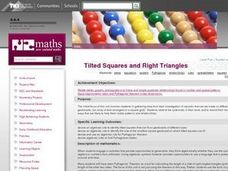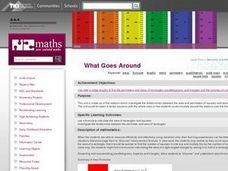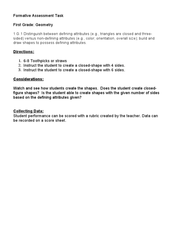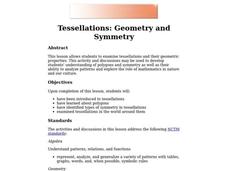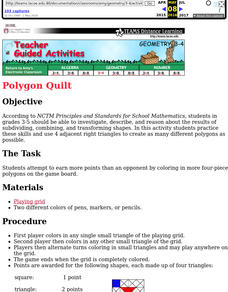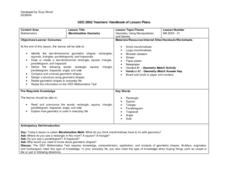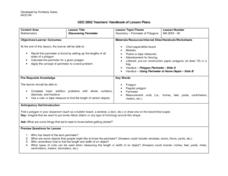Curated OER
Tessellation Trial and Error
In this interactive lesson, students review attributes of equilateral polygons. They are introduced to the concept of a tessellation. Using protractors and pre-cut shapes, students arrange a variety of tiles to create tessellations. They...
Curated OER
Quilt Geometry
Seventh graders explore lines of symmetry, congruent polygons and patterns. They listen to "The Seasons Sewn," observe a PowerPoint presentation, and identify congruent polygons and visual patterns. Through an internet activity, 7th...
Curated OER
Shapes
Students review basic shapes, such as circles, squares, triangles, and rectangles, find objects in those shapes in classroom, watch Clifford's Fun with Shapes video, practice reproducing four shapes, and rotate through four classroom...
Curated OER
Pondering Polygons
Seventh graders use block letter writing to help classify polygons. They use their own names which helps to keep them engaged during the activity. Finally, 7th graders play a classification game naming different polygons.
Curated OER
Area of Rectangles
Seventh graders review the concept of finding the areas of a rectangle. This lesson uses the classroom as a real life application for the formula of area. They measure classroom in order to compute the area.
Curated OER
Polygon Monster
Students brainstorm different kinds of shapes. They then draw them on the paper and write the name of the shape on the back and then assemble the shapes to make a "monster". Students make up a survey about the monster including its name...
Curated OER
Strut Your Stuff
Students begin the lesson plan by identifying what a polygon is and hypothesizing how many struts (diagonals) it would take to make a polygon rigid. They watch a "Magic School Bus" episode then experiment with various shapes to make a...
Curated OER
Geometry and Shapes in the X-36
Learners describe, draw, and classify shapes. They use the internet to research the X-36 aircraft. Students identify the geometric shapes in the aircraft. They calculate the number of sides in an x-36.
Curated OER
Tilted Squares and Right Triangles
Students investigate squares. They generate patterns from structured situations and find a rule for the general term and express it using words and symbols. Students generate patterns from a rule and substitute values and formulas.
Curated OER
What Goes Around
Fourth graders investigate the relationships between the area and perimeters of squares and rectangles. They calculate the perimeter of rectangles and squares using a formula. Students investigate the relationship between the perimeter...
Curated OER
Geometry
Learners are introduced to the basics of Geometry. Using cutout shapes, they identify whether they are polygons by using the properties of polygons. They practice drawing shapes they are going to be using on an everyday basis and...
Curated OER
Areeas of Parallelograms and Triangles
Twelfth graders are able to deduce the area of polygons by using several methods such as coordinate method. They are able to apply the area of polygons to real life situations. Students apply the Pythagorean Theorem in problem solving...
Curated OER
Tessellations: Geometry and Symmetry
Students examine tesselllations and their geometric properties. They have a better knowledge of polygons, can identify types of symmetry in tessellations. Also students use visulization, spatial reasoning, and geometric modeling to...
Curated OER
Equivalent Fraction Quilts
Fifth graders practice fraction skills by making quilts using paper or cloth for the squares and rectangles. Each square of the quilt is an equivalent fraction which they design. Students can also use this activity to demonstrate how to...
Curated OER
Mathematics in Art?
Fifth graders view prints of M.C. Escher's work. They look at examples of geometric figures and polygons and discuss places they have seen them. Students create their own tessellations. They write a report about the process they used in...
Curated OER
Polygon Quilt
Students participate in a game with different types of polygons. They use triangles to create as many polygons as possible. They also review their colors by having different polygons be a different color.
Curated OER
A Cylinder Workshop
Learners work with given formulas to solve for specific variables. The calculation of the volume of a cylinder and the change in volume when there is a constant surface area is analyzed in this lesson.
Curated OER
Why Do We Add The Bases To Find The Area of A Trapezoid?
Middle schoolers are given patterns of trapezoids and are to calculate the area of one trapezoid by using both patterns. They should form a parallelogram and calculate the area. They practice this technique until there is understanding.
Curated OER
A Dreamer's Cloak
Learners listen to the teacher read "A Dreamer's Cloak." They examine the difference between squares and circles and create their own cloak by using a paper bag and different shapes.
Curated OER
"School Shape Scavenger Hunt"
Students, in groups, venture onto the schoolground on a scavenger hunt for shapes. They are given tasks: recorder, team leader, presenter, reporter, and behavior guidelines and a time limit. They search the school for shapes found in...
Curated OER
Polygon Mobiles
Students explore a variety of shapes and angles and create mobiles with information about a selected polygon. Both common and "not-so common" polygons are examined.
Curated OER
Marshmellow Geometry
Students explore a variety of geometric shapes, name them, and list their characteristics. The shapes are transposed into structures and checked for accuracy.
Curated OER
Discovering Perimeter
Twelfth graders apply perimeter measurement to items found in newspapers and calculate the cost in terms of feet or yards. They share answers and explanations with classmates.
Curated OER
Area of Parallelograms and Triangles
Students explain the formula for finding the area of a paralellogram and its relation to the area of a rectangle. Finally, they construct the formula for the area of a paralellogram.










